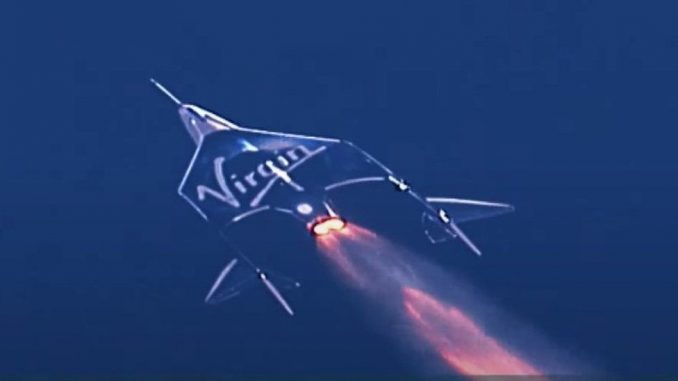
Billionaire Sir Richard Branson successfully reached the edge of space on board his Virgin Galactic rocket plane.
The UK entrepreneur flew high above New Mexico in the US in the vehicle that his company has been developing for 17 years.
The trip was, he said, the "experience of a lifetime".
He has now returned safely to earth with his crew.
It makes him the first of the space tourism pioneers to reach space, beating Tesla's Elon Musk and Amazon's Jeff Bezos.
We await official confirmation of the height reached by Sir Richard, but it appears to have been 85km (282,000ft; 53 miles).
He was accompanied on the mission by Unity's two pilots, Dave Mackay and Michael Masucci, and three Galactic employees – Beth Moses, Colin Bennett and Sirisha Bandla.
Sir Richard billed the flight as a test of the space tourism experience he expects to begin selling to customers from next year.
Wally Funk, 82, to join Bezos space flight
Branson gains licence for commercial spaceflights
Some 600 individuals have already paid deposits for tickets that will cost them up to $250,000
These are all people who want to reach a height where they can see the sky turn black and marvel at the Earth's horizon as it curves away into the distance. Such a flight should also afford them about five minutes of weightlessness during which they will be allowed to float around inside Unity's cabin.
lol
It's been a long road for Sir Richard to get to this point. He first announced his intention to make a space plane in 2004, with the belief he could start a commercial service by 2007.
But technical difficulties, including a fatal crash during a development flight in 2014, have made the space project one of the most challenging ventures of his career.
"I've wanted to go to space since I was a kid, and I want to enable hopefully hundreds of thousands of other people over the next 100 years to be able to go to space," Sir Richard, stated.
"And why shouldn't they go to space? Space is extraordinary; the Universe is magnificent. I want people to be able to look back at our beautiful Earth and come home and work very hard to try to do magic to it to look after it."
Space tourism is a sector being rekindled after a decade's hiatus, and it's about to get very competitive.
Throughout the 2000s, seven wealthy individuals paid to visit the International Space Station (ISS). But this adventurism, organised under the patronage of the Russian space agency, ceased in 2009.
Now, new initiatives abound. As well as Sir Richard's approach, there are projects coming from Amazon.com founder Jeff Bezos and the California tech entrepreneur Elon Musk.
The Russians, too, are reprising their commercial flights to the ISS, and there are even those who want to launch private space stations for people to visit. Among these is Axiom, a company started by a former Nasa ISS programme manager.
Sir Richard received a message of goodwill from Mr Bezos on Saturday, although there is clearly some edge in their relationship.
A day earlier, Mr Bezos's Blue Origin space company had issued a tweet that took a pop at Virgin Galactic's Unity vehicle. The posting repeated a claim that anyone who flew on the rocket plane would forever have an asterisk by their name because they wouldn't reach the "internationally recognised" altitude for where space begins – the so-called Kármán line of 100km.
The US government, however, has always recognised the boundary of space to be at about 80km (50 miles) and it awards astronaut wings to anyone who exceeds this altitude. Before Sunday, only 580 people had ever been above this height.
Unity is a sub-orbital vehicle. This means it can't achieve the velocity and altitude necessary to keep it up in space to circle the globe.
The vehicle is designed to give its passengers stunning views at the top of its climb and allow them a few minutes to experience weightlessness.
Unity is first carried by a much bigger aeroplane to an altitude of about 15km (50,000ft), where it is released.
A rocket motor in the back of Unity then ignites to blast the ship skyward.
The maximum height achievable by Unity is roughly 90km (55 miles, or 295,000ft). Passengers are allowed to unbuckle to float to a window.
Unity folds its tailbooms on descent to stabilise its fall before then gliding

Be the first to comment